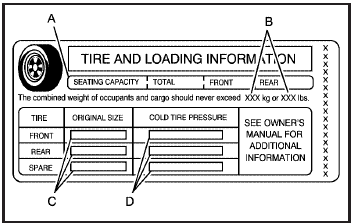Tire and Loading Information Label

Label Example
A vehicle specific Tire and Loading Information label is attached to the vehicle’s center pillar (B-pillar). With the driver door open, you will find the label attached below the door lock post (striker).
The Tire and Loading Information label lists the number of occupant seating positions (A), and the maximum vehicle capacity weight (B) in kilograms and pounds. The vehicle capacity weight includes the weight of all occupants, cargo, and all nonfactory-installed options.
The Tire and Loading Information label also lists the tire size of the original equipment tires (C) and the recommended cold tire inflation pressures (D). For more information on tires and inflation, see Tires and Inflation - Tire Pressure.
There is also important loading information on the Certification label. It tells you the Gross Vehicle Weight Rating (GVWR) and the Gross Axle Weight Rating (GAWR) for the front and rear axle, see “Certification Label” later in this section.
See also:
Windshield and Wiper Blades
Clean the outside of the windshield with glass cleaner.
Clean rubber blades using lint-free cloth or paper towel soaked with windshield
washer fluid or a mild detergent. Wash the windshield thoroug ...
Retained Accessory Power (RAP)
These vehicle accessories can be
used for up to 10 minutes after the
engine is turned off:
• Audio System
• Power Windows
• Sunroof (If Equipped)
• Auxiliary Power Outlet
Power to the ...
Safety Belts
Safety Belts
Refer to the following sections for
important information on how to use
safety belts properly:
• Safety Belts.
• How to Wear Safety Belts
Properly.
• Lap-Shoulder Belt.
...


